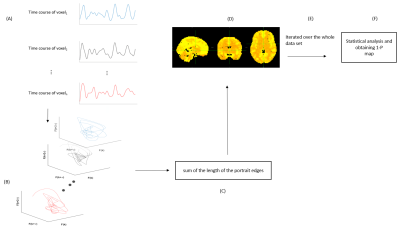Zhenhai Zhang1, Kaiming Li2, and Xiaoping Hu2
1Department of Electrical and Computer Engineering, University of California,Riverside, Riverside, CA, United States, 2Department of Bioengineering, University of California,Riverside, Riverside, CA, United States
1Department of Electrical and Computer Engineering, University of California,Riverside, Riverside, CA, United States, 2Department of Bioengineering, University of California,Riverside, Riverside, CA, United States
With
phase space embedding, we reconstructed the phase portrait of BOLD signals and
calculated the sum of the length of the portrait edges (SE). Statistical
parametric maps of SE showed that it could be a viable disease biomarker.

Fig.2: Overview of the methods. (A): Preprocessed BOLD time courses from a single subject; (B): Reconstructed phase attractors in the 3D space ;(C) Feature extraction by calculating the sum of the length of the portrait edges (SE) for each attractor;(D): Calculated SE map of a subject; (E): Iteration of (A)-(D) over all subjects of the datasets; and (F): statistical analysis.
